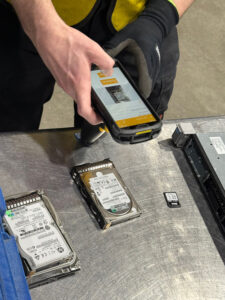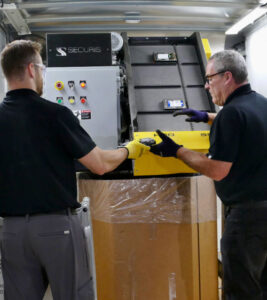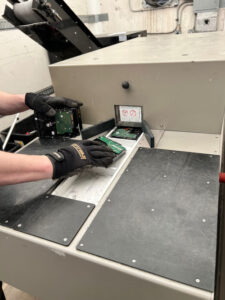Retiring Data Center Equipment
From Racks to Recycling: A Secure and Sustainable Process for Retiring Data Center Equipment
At some point, every data center faces the same moment.
The hum of servers, once the heartbeat of your infrastructure, goes quiet. Cables are unplugged. Carefully configured systems begin their final countdown. While powering down and decommissioning equipment may feel like the end, for IT leaders, retiring data center equipment is just the start of a high-stakes, risk-intensive process.
What happens next isn’t as simple as flipping a switch or carting out old hardware. It’s a process that demands precision, planning, and a deep understanding of the potential risk. Missteps can lead to data breaches, regulatory penalties, reputational damage, and missed opportunities for value recovery. However, done right, data center decommissioning becomes a strategic opportunity to strengthen compliance, recover value, and align with organizational ESG goals.
This guide outlines the full lifecycle of data center decommissioning, with real-world questions you should consider before the job begins. These insights will help you prepare, avoid delays, and confidently execute your decommissioning strategy.
Download our handy Data Center Decommissioning Checklist
Phase 1: Shutdown Strategy – Building the Foundation
 Decommissioning begins at the planning table long before a single asset is unplugged or wheeled out the door. The planning phase lays the foundation for a successful decommissioning. When done right, this is where the process can gain strength and efficiency; when done poorly, the seeds of future complications are sown.
Decommissioning begins at the planning table long before a single asset is unplugged or wheeled out the door. The planning phase lays the foundation for a successful decommissioning. When done right, this is where the process can gain strength and efficiency; when done poorly, the seeds of future complications are sown.
Picture this: an IT manager is told that a facility is shutting down in 60 days. Servers need to be cleared, racks dismantled, and all infrastructure gone. That’s tight but doable. What’s not immediately visible is the massive web of interdependencies—teams to coordinate, assets to tag, data to classify, and compliance obligations that don’t end when the servers shut down.
This is why a shutdown strategy matters. It’s not just about logistics—it’s about creating clarity. The goal isn’t just knowing what you have, it’s having a defensible, documented baseline for data destruction, value recovery, and compliance. The best partners ask tough questions—and help you confidently answer them.
You should begin with a complete asset inventory: servers, storage arrays, switches, racks, PDUs, cabling, and even small or obscure devices should be noted. You should also know:
- Who owns the equipment—your company, a leasing firm, or a third party?
- What exactly needs to be removed—and what stays behind?
- Who has the authority to approve work and sign off on completion?
- Can your vendor perform a site walk-through before the job begins?
These questions aren’t trivial—they’re operational guardrails that help your ITAD partner quote accurately, assign resources efficiently, and avoid scope creep. This is also where chain-of-custody planning becomes critical.
You will want to help your vendor understand:
- Full site details, including access restrictions and parking
- Loading dock specs (consider questions like: is a dock plate needed? Is a freight elevator available? Is it a long distance from the equipment to the dock or staging area?
- Can the work happen during regular business hours?
- Who will handle facility access and escort requirements?
- Is broom sweeping or floor protection required?
Even the status of your racks matters: Are they bolted to the floor? Ganged together? Will they fit through doorways without tipping? The more details you can provide upfront, the fewer surprises later.
At this stage, risk classification is also very important. Not all assets carry the same weight. Some devices contain sensitive or regulated data—PII, PHI, financial information, or national security material. Others may be empty shells. With the help of a qualified IT asset disposition partner, it’s your job to identify what’s what based on data sensitivity and regulatory requirements. Using NIST 800-88 guidelines, some devices may qualify for secure reuse or resale, while others must be physically destroyed, shredded, or disintegrated beyond recovery.
Critical questions you will need to consider in partnership with your ITAD provider include:
- Are data drives still in place? And what kind of drives do you have? (HDD, SSD, tape, mobile)
- Will on-site shredding or degaussing be required?
- How many drives will need to be destroyed?
- Which, if any, data-bearing assets can be redeployed, resold, or donated?
- Does the data destruction need to be witnessed by a staff member?
- Do you have an internal equipment inventory tracking system?
And if value recovery is a goal, be prepared to share:
- Photos of the racks and assets
- Model numbers and serials for valuation
- An inventory list (or request help building one)
In addition to the considerations above, you also want to ensure that the IT asset disposition partner you choose comes to the table with more than a truck and a pickup date. Look for certifications demonstrating process maturity and alignment with any data privacy regulations you must comply with.
- NAID AAA certification for on-site and off-site data destruction services.
- ISO 9001, 14001, 45001 certifications
- R2v3 certification for environmental regulations
- DLA/DOT clearance for secure transport
You should also understand how your ITAD vendor approaches Inventory tracking. An accurate inventory list isn’t just helpful—it’s defensible. In a post-project audit or compliance review, the ability to trace every asset from rack to final disposition protects your team and your organization. When choosing an IT asset disposition (ITAD) vendor, ensure your vendor uses advanced and accurate inventory tracking to account for every asset at every stage of the decommissioning process. Also, understand how long it will take to access your inventory reporting. The best ITAD vendors will provide detailed inventory lists and certificates of destruction within 72 hours of job completion, but some take months to provide this information. It’s also a plus if you can access your project information 24/7 via a client portal.
The most successful decommissioning projects treat planning as a risk-reduction strategy, not just a task to check off. By taking the time to map every move before it happens, IT leaders avoid the most common pitfalls: misplaced assets, data leaks, project delays, and unexpected costs. In short, this isn’t just the shutdown phase—it’s the blueprint for everything that follows.
Phase 2: Secure Data Destruction – Eliminating Hidden Risk
 By the time your racks are empty and devices are staged for removal, the most visible parts of decommissioning may feel complete. But the real risk often lies inside the devices you can no longer see—in residual data tucked away in hard drives, flash storage, network devices, or embedded systems.
By the time your racks are empty and devices are staged for removal, the most visible parts of decommissioning may feel complete. But the real risk often lies inside the devices you can no longer see—in residual data tucked away in hard drives, flash storage, network devices, or embedded systems.
Data doesn’t disappear. It lingers in unexpected places: a forgotten backup device, a customer list stored on a decommissioned firewall, an admin password cached in a printer. Even a single overlooked drive can trigger compliance violations or reputational damage. That’s why secure data destruction is not a step to gloss over. It is the beating heart of any decommissioning project.
The best ITAD vendors provide:
- NIST 800-88–compliant wiping for resale-ready assets
- Degaussing for magnetic media
- Shredding or disintegration for SSDs and high-security environments
- NSA-approved equipment with documentation
- Ability to witness destruction
- Documented destruction with easily accessible Certificates of Destruction
The primary standard for media sanitization is NIST 800-88, and any reputable ITAD partner should follow it and build their destruction methods around it. That starts with understanding the different types of drives and devices in your data center—HDDs, SSDs, flash-based systems, legacy tapes, and the kind of content stored on those devices and drives, and matching each to the appropriate data sanitization method.

Compliant software-based data wiping works well for hard drives designated for reuse or resale. This method overwrites every sector of the drive and verifies success before generating a Certificate of Destruction. However, not all assets are deemed good candidates for reuse. For those, physical destruction is deemed the better option.
Degaussing is a physical destruction method effective for magnetic drives, disrupting data through powerful electromagnetic fields. However, it has no effect on SSDs. That’s where shredding or disintegration comes in. Shredding devices to industry-standard particle sizes ensures that no data can be reconstructed. Disintegration goes even further, especially for small-form-factor devices such as flash or SSD cards, turning them into dust-sized fragments that render data utterly unrecoverable.
An experienced ITAD partner will not only offer all of these services—they’ll also know which to recommend based on your assets, data classification, and compliance needs. They should use only certified equipment and document every destruction event, preferably with advanced inventory techniques, and provide the option for on-site or off-site services, depending on your risk tolerance and logistics.
Data destruction is often the most invisible but consequential phase of the decommissioning journey. When it’s done right, no one notices. When it’s done wrong, everyone will.
Phase 3: Value Recovery, Redeployment, and Donation – Extending the Life of Your IT Assets
While some assets are destined for destruction, many still have value to offer, and smart organizations know how to capture it.
 This phase is about more than maximizing financial return. It’s about making the most of what you already own. That might mean reselling equipment with market value, redeploying it within your organization, or donating it to support social impact and ESG goals. The key is knowing what to do with what you’ve got.
This phase is about more than maximizing financial return. It’s about making the most of what you already own. That might mean reselling equipment with market value, redeploying it within your organization, or donating it to support social impact and ESG goals. The key is knowing what to do with what you’ve got.
For assets that retain resale value, your ITAD partner should offer fair-market appraisals and revenue-sharing models that return real dollars to your bottom line. Don’t settle for vague quotes or hidden fees. Transparency is key, especially when tying recovered value to sustainability goals or budget reporting.
Some assets may be more useful within your own walls than on the secondary market. Internal redeployment is an excellent strategy for extending the life of hardware in non-critical roles, such as QA environments or training labs. Your IT asset disposition vendor should help facilitate safe sanitization, reinstallation, and the transport of refurbished assets back to your organization.

Then there are the assets that, while no longer commercially viable, are still perfectly functional. Donation isn’t an afterthought—it’s a strategic lever for social impact and ESG alignment. Donating equipment to vetted nonprofit partners, schools, or global digital equity initiatives creates measurable social impact. It aligns with ESG frameworks, boosts your organization’s CSR profile, and puts useful technology into the hands of those who need it most.
A standout example comes from a recent project where refurbished laptops were donated to communities in Chad and Cameroon. After undergoing certified data destruction and refurbishment, these devices now support education, healthcare, and digital literacy programs—bridging the digital divide and giving legacy hardware a powerful second act.
Whether it’s dollars back to your budget or value to the community, this phase is about turning retired assets into new opportunities. Ensure your ITAD partner has the experience, network, and documentation to make it happen securely, transparently, and responsibly.
Phase 4: Responsible Recycling – Closing the IT Lifecycle Loop
 When reuse, resale, or donation aren’t viable, responsible recycling becomes the final—and critical—step.
When reuse, resale, or donation aren’t viable, responsible recycling becomes the final—and critical—step.
This is where sustainability and compliance intersect. Improper disposal of IT equipment doesn’t just harm the environment; it can also put your organization at risk of fines, public scrutiny, and missed ESG benchmarks. Electronics contain hazardous materials like mercury, lead, and cadmium—substances that must be handled properly to avoid polluting soil, water, and communities. EPA Guidelines recommend that your ITAD partner be R2v3 certified, which confirms their commitment to responsible downstream recycling, environmental compliance, and worker safety. But certification alone isn’t enough. They should offer complete transparency into where your e-waste ends up, maintain detailed documentation, and ensure that all downstream vendors meet the same high standards.
Responsible recycling isn’t just the right thing to do; it’s a brand protection strategy. In a time when consumers, investors, and regulators are paying close attention to sustainability practices, what your organization does with its retired IT equipment matters. ESG commitments only matter when backed by verifiable action and documentation. Closing the loop with sustainable recycling shows you’re serious about minimizing waste, maximizing reuse, and protecting both people and the planet.
Phase 5: Reporting & Compliance – Turning Documentation into Peace of Mind

If you’ve followed the steps above, you’ve reduced risk, recovered value, and upheld sustainability. But none of it counts unless you can prove it.
That’s why comprehensive reporting and compliance documentation are any decommissioning project’s final—and arguably most important deliverables. When assets are retired, data is destroyed, and materials are recycled, you need audit-ready evidence at your fingertips.
This is especially critical for organizations governed by data privacy and industry-specific regulations: HIPAA and HITECH in healthcare, GLBA and FFIEC in finance, SOX for public companies, FISMA and NIST for federal contractors. Compliance isn’t optional—it’s a mandate, and your ability to demonstrate conformance can mean the difference between smooth sailing and a regulatory nightmare.
 Your ITAD partner should provide Certificates of Destruction, detailed asset tracking from pickup through final disposition, and access to secure portals for real-time status updates and downloadable reports. They should be familiar with your regulatory landscape and able to deliver documentation that satisfies not only your compliance team but also your legal, procurement, and finance stakeholders.
Your ITAD partner should provide Certificates of Destruction, detailed asset tracking from pickup through final disposition, and access to secure portals for real-time status updates and downloadable reports. They should be familiar with your regulatory landscape and able to deliver documentation that satisfies not only your compliance team but also your legal, procurement, and finance stakeholders.
Equally important is timeliness. Reports delivered weeks after the fact do little to help you during a surprise audit or board meeting. The gold standard: accurate, complete reports delivered within three business days.
In short, documentation isn’t paperwork. It’s protection. It’s assurance. It’s what transforms a completed decommissioning project into a verifiable success.
From Decommissioned to Done Right
Retiring data center equipment isn’t just a logistical task. When managed thoughtfully, it’s a strategic process that can strengthen your organization’s security posture, regulatory standing, sustainability performance, and bottom line.
For IT managers, this means looking beyond just powering down. It means partnering with an IT asset disposition provider that brings transparency, accountability, and expertise to every phase—from initial planning to final reporting. When you work with the right partner, you don’t just decommission equipment. You retire it with confidence, integrity, and purpose. Learn more about creating an RFP for your ITAD Vendor in this article.
Because the next chapter of your infrastructure starts with how you close this one.
Download our handy Data Center Decommissioning Checklist